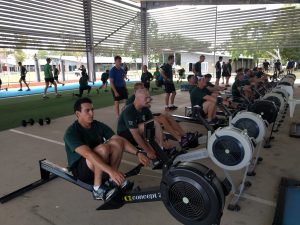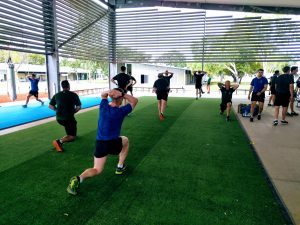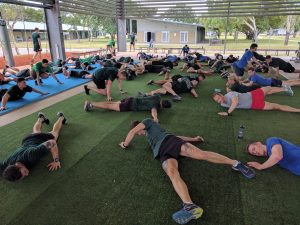Innovation is a hot topic at the moment; however 'imitation' can be just as effective, if not more so, and often requires less effort. The 1st Battalion Royal Australian Regiment (1 RAR) has a tale to share of effective imitation, driven from the bottom up, that led to practical improvements in how we physically prepare soldiers for war.
In 2015 the rumblings of change were beginning to be felt. Sergeant Dale Gorman, the 1 RAR Physical Training Instructor (PTI), understood that our methods for physical training needed renovating. He proposed that infantry soldiers would be better trained through structured strength training – imitating how many professional athletes and sports teams train for success. His program, dubbed the Advanced Operational Conditioning Program (AOCP), soon gained traction with the command team for its potential and it was swiftly implemented.
The AOCP incorporates periodised strength training, predominantly using barbell compound movements[1], alongside conditioning[2] training. The program focuses on training four lifting activities: the back-squat, the dead-lift, the shoulder-press, and the floor-press (akin to bench-press). Weekly programming includes two strength and strength endurance sessions (weight lifting); an aerobic session; a recovery, mobility and/or skills session; and a military endurance enhancement session – ordinarily in the form of a pack march or battle physical training (PT). When applied, the AOCP develops suitable levels of strength and endurance that, in turn, improve mobility on the battlespace – It conditions combat fitness.[3]

The uniqueness of the AOCP soon attracted the attention of experts from James Cook University (JCU) who were interested in understanding how to optimally prepare soldiers and teams, physically, for combat. With two organisations, each masters in their respective field, working together to attain elite levels of expertise, the potential was promising. The ensuing collaboration between JCU and 1 RAR tested the AOCP and evaluated its effectiveness – the outcomes of which are now under review for publishing in The Journal of Strength and Conditioning Research. The results demonstrated that improvements from strength training directly translate to improvement in movement activities common in a tactical environment (loaded running, marching and fire & movement drills). In a series of tests specifically designed to mimic actions in combat[4], soldiers undergoing strength training performed far better than those who were not.
These findings are not surprising, and the trial was not particularly innovative. In fact the athletic community has understood the importance of strength training for a long time[5]. However, JCU’s research is important because it specifically involved a military population in a real training environment, alongside the inherent challenges that presented – something rare in human performance studies, providing clear ecological validity.
With this information, it is hard to argue that we should not imitate what many professional sports and athletic teams are already doing – that is, training with weights. With this knowledge in hand, and as a beneficial addition to the topic, let’s look at how units can implement strength training. First, there are no 'free lunches’ and achieving superior performance through quality training comes at a cost. That cost is equipment. A lack of equipment is an issue that needs resolution at a level above the user units – above the practitioners. This cost, need for better equipment and need to be ‘better-equipped’ is something Army Headquarters (AHQ) must accept. If we agree this cost is necessary, then AHQ should pursue how to equip units to be capable of better training. They should strive to get units the tools they need to hone their edge over any potential adversary.
While we wait for resource support, the stated equipment problem is something each unit must take ownership of. Many other units in the 3rd Brigade have aptly identified the AOCP’s merits and adopted the program. They are working around their internal issues, with more units to follow shortly. In the absence of their own equipment, 2nd Cavalry Regiment and 2nd Close Health Company both organised to make use of 1 RAR's facilities for their own AOCP training. 2nd Battalion Royal Australian Regiment are being smart about how they program the use of their limited facilities by letting small teams conduct their AOCP sessions in a flexible fashion throughout the day. AOCP is without doubt better training, and the onus is on units to ‘find a way’ until the Army provides adequate solutions.

Thankfully, a degree of strength training is doable without equipment. A raft of other options exist with only a little research required. Ever seen gymnasts (some of the strongest humans on that planet) train? They can do a lot with not a lot of equipment[6]. Consulting your local PTI is always a great start and they can also provide you suitable progressions for blocks of training. Furthermore, if you have equipment but only a limited amount, then some creative timetabling for the use of that equipment could ensure that everyone gets a turn. Slaving ourselves to PT at 0730 h because ‘that’s how we have always done it’ does not suffice any longer. The driving force behind pursuing excellence in any training is, like most things, a command responsibility and must be unrelentingly pursued by our leaders.
Ultimately, what the AOCP offers that is truly different to the past is acknowledgement that strength training is important. It gives us time in the training program to perform dedicated weight lifting, alongside more traditional conditioning. There is a risk – and that risk is that we use current limitations as an excuse to continue ‘doing it how we always have’. Doing so would be criminal and, if we truly want to consider ourselves as professionals, we cannot afford to ignore what science tells us is optimal. Modern research demonstrates that the AOCP is better than ‘old-school’ physical training, and can be better tailored for the individual. Whilst limitations will always exist, solutions are relatively simple if we understand the intent of AOCP and adapt it to our circumstances.
To wrap up, what does the AOCP’s story teach us about innovation, or rather imitation? That great ideas are everywhere but not always new. The AOCP was driven by soldiers who intuitively knew we could train better and supported by commanders with an open mind. The result not only led to better training, but created other opportunities in the field of human performance including future collaboration with James Cook University for human performance research (watch this space). Importantly, these outcomes would never have been possible without the merciless support of commanders – at all levels. Finally, I encourage everyone to remember innovation can be chaotic and unpredictable. Save the innovative ideas for deeper consideration and maybe they will become useful. Instead, let’s look at what other experts are doing and copy them – ruthlessly. To put it another way, good artists copy; great artists steal[7].
For more information, visit the 1 RAR YouTube channel, which will have AOCP specific video information in the near future. If you are interested in the science, don't forget to keep an eye out for the AOCP’s research findings that are currently under review for publishing in the The Journal of Strength and Conditioning Research.

Advanced Operational Conditioning Program Assessment (AOCP-A)
Conducted over two consecutive days to simulate mission requirements encountered by Royal Australian Infantry (RAINF) soldiers on exercise and operations.
Day one consists of three strength endurance activities and one assessment of combat aerobic capacity:
- cadence push-ups (1:3 second cadence)
- pull-ups, any grip
- feet un-held sit ups; (1:3 second cadence)
- 2.4 km best effort webbing run in patrol order with 12-15 kg external load including weapon.
Day two consists of three aerobic combat endurance activities and one assessment of combat anaerobic capacity:
- 10 km timed best effort weight loaded march (WLM) with 25 kg external load including weapon no longer than (NLT) 100 minutes
- 150m simulated section attack and grenade throw in patrol order with 12-15 kg external load including weapon accuracy within 5 m radius
- 400 m best effort combat swim (any stroke) in disruptive pattern camouflage uniform (DPCU) without boots in less than 18 minutes
- 10 Minute tread water in DPCU without boots.









